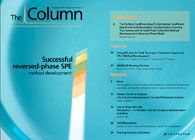Ancient smoke signals
A team of researchers has proved that the Ancient Mayans used tobacco. The discovery was prompted by the examination of several ancient Mayan containers from the Kislak Collection of the US Library of Congress for the presence of alkaloids.
A team of researchers has proved that the Ancient Mayans used tobacco. The discovery was prompted by the examination of several ancient Mayan containers from the Kislak Collection of the US Library of Congress for the presence of alkaloids.1
One of the flasks had text upon it that read yo-‘OTOT-ti ‘u-MAY; ‘the home of its/his/her tobacco’. Samples were extracted from the flask and analysed by gas chromatography/mass spectrometry and liquid chromatography/mass spectrometry. Nicotine was discovered to be the major component of the extracts. They also found three oxidation products of nicotine. High-resolution high mass accuracy tandem mass spectrometry spectra of protonated nicotine and nicotine mono-oxides were measured to verify previous product ion assignments. These analyses identified the flask as a likely holder of tobacco leaves.
In addition, the tobacco contained in the flask was so strong that it may have been hallucinogenic.
Ultimately, the research concluded that this is the first physical evidence of tobacco from a Mayan container, and only the second instance where the vessel content demonstrated in a Mayan hieroglyphic text has been confirmed directly by chromatography/mass spectrometry analysis.
1 Dmitri Zagorevski et al., Rapid Communications in Mass Spectrometry, DOI: 10.1002/rcm.5339 (2012).
This story originally appeared in The Column. Click here to view that issue.

New TRC Facility Accelerates Innovation and Delivery
April 25th 2025We’ve expanded our capabilities with a state-of-the-art, 200,000 sq ft TRC facility in Toronto, completed in 2024 and staffed by over 100 PhD- and MSc-level scientists. This investment enables the development of more innovative compounds, a broader catalogue and custom offering, and streamlined operations for faster delivery. • Our extensive range of over 100,000 high-quality research chemicals—including APIs, metabolites, and impurities in both native and stable isotope-labelled forms—provides essential tools for uncovering molecular disease mechanisms and exploring new opportunities for therapeutic intervention.
New Guide: Characterising Impurity Standards – What Defines “Good Enough?”
April 25th 2025Impurity reference standards (IRSs) are essential for accurately identifying and quantifying impurities in pharmaceutical development and manufacturing. Yet, with limited regulatory guidance on how much characterisation is truly required for different applications, selecting the right standard can be challenging. To help, LGC has developed a new interactive multimedia guide, packed with expert insights to support your decision-making and give you greater confidence when choosing the right IRS for your specific needs.

.png&w=3840&q=75)

.png&w=3840&q=75)



.png&w=3840&q=75)



.png&w=3840&q=75)











